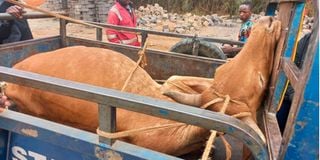Premium
Hey, for good yields, treat animals with lots of love and respect

A cow is transported in a cruel manner at Makutano junction in Kirinyaga County last week.
Human beings are considered the most advanced and intelligent animals on the planet. They have dominance over all other animals, from the smallest to the largest.
Humans control animals directly using physical, chemical and persuasive means. Indirectly, humans control animals by impacting on their environment for good or the bad of the animals.
However, in his pursuit to control other animals for various reasons, man often impacts negatively on both domestic and wild animals. The negative impact is conventionally referred to as animal abuse or cruelty.
Animal abuse may be active or passive. Active abuse is when someone takes deliberate and aggressive actions against animals to hurt or torture them to fulfil self-gratification.
Active cruelty to animals is of serious consequences because this can be transferred to people. The Federal Bureau of Investigations (FBI) of the US found that there is a relationship between animal abuse and domestic violence, child abuse and psychopathic tendencies.
From January 2016, the FBI started collecting detailed data on acts of animal cruelty and counting them alongside crimes such as arson, burglary, assault and homicide.
Malicious motive
Passive abuse, on the other hand, occurs when people make animals suffer without malicious motive. It is the most common form of animal abuse, mainly occurring due to the quest to maximise profits from animal business. Most dairy cattle in zero-grazing farming are grossly abused. The main violation is denial of sufficient food and water and provision of shelters that are very uncomfortable to the animals.
In general, passive animal abuse is very common where animals are kept in confinement or during transport.
This brings me to an incident I encountered last week at the Makutano junction in Kirinyaga County. During the course of my work, one of my colleagues and I saw a cow on the carrier of an improvised motorcycle. The carrier length only fitted the cow up to the shoulders.
To fit the cow’s body, the transporter had tied the horns with a rope and fixed the neck and the head to the front vertical bars of the carrier. The legs were tied and the animal made to lie on the floor of the carrier. It was definitely a very painful and uncomfortable transport position for the poor cow.
We stopped the vehicle, introduced ourselves to the driver and the owner of the animal as veterinary doctors and inspected the animal. It was obviously in pain, fear and distress. The eyes were wide open, breathing was heavy and laboured and there was a bleeding injury around the left eye.
Fortunately, the cow had been made to lie on its right side. Otherwise, it would have accumulated gas in the rumen and possibly died during transport. We learnt from the driver the lying position on the right was just by chance and not out of knowledge on cattle digestion.
The animal owner was taking it to the market for sale. We also learnt from the owner and the transporter that they had no knowledge of animal welfare or any law that regulates the welfare of animals.
We asked them to offload the animal to walk the remaining distance of about 500 metres to the market or look for a suitable transport vehicle.
The animal was offloaded and could hardly stand. It was disoriented and kept staggering due to the effects of the folded-up transport position. Eventually it stabilised and we left.
Have feelings
The most common cause of animal abuse is lack of awareness that animals, like humans, have feelings. And there are laws governing animal welfare. In Kenya, there is Chapter 360 of the Laws of Kenya, Prevention of Cruelty to Animals Act. It explains what constitutes animal welfare and the penalties for violation of the legal provisions.
The basic penalty is Sh3,000 or a six months jail term or both.
Article 30 of the law empowers any person to prevent cruelty to animals. Licensed officers are also empowered to enter and inspect land, premises and vehicles in suspected cases of cruelty to animals.
Generally, the Act is premised on the five conventional animal freedoms. The first states that animals should enjoy the freedom from hunger and thirst. They should be provided with sufficient nutritious feed and water to drink at will.
Animals should enjoy freedom from discomfort at all times. The third freedom seeks to protect animals from pain, injury and disease. Fourth is the freedom to express normal behaviour in different situations such as happiness, sadness, empathy, anxiety, need and breeding, among others.
Finally, animals should enjoy freedom from fear and distress. They can experience fear and distress due to loud noises, the introduction of intimidating animals such as dogs among sheep or acts such as slaughtering an animal in full view of others or in the range of smelling blood.
Farmers should know that observing the five animal freedoms also enables them to produce at their optimum.





